Healing Circle Project: Social Determinants, Principles and Strategies
VerifiedAdded on 2022/11/30
|9
|2042
|394
Report
AI Summary
This report analyzes the 'Healing Circle' project, a primary health care initiative in Western Australia addressing sexual assault trauma. The project's needs were determined by social determinants like social support networks and education, emphasizing community participation and empowerment. Guided by the Ottawa Charter, the project strengthened community action and promoted health. Cultural competence was deemed essential for staff to effectively address the needs of vulnerable people. The report highlights the project's alignment with primary health care principles and strategies, advocating for community involvement, education, and culturally sensitive care to improve the well-being of the community. The assignment adheres to the provided guidelines, including word count, referencing, and formatting requirements.
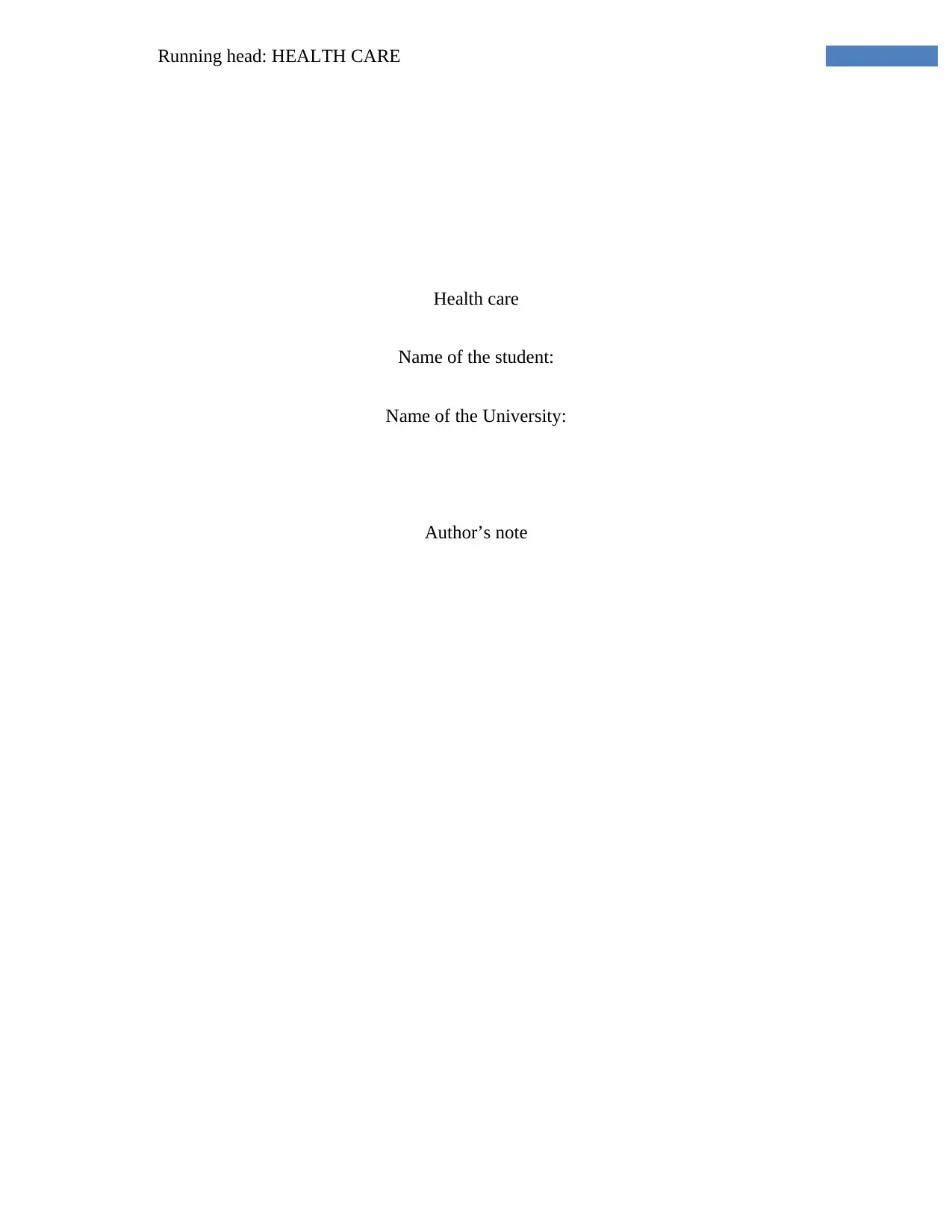
Running head: HEALTH CARE
Health care
Name of the student:
Name of the University:
Author’s note
Health care
Name of the student:
Name of the University:
Author’s note
Paraphrase This Document
Need a fresh take? Get an instant paraphrase of this document with our AI Paraphraser
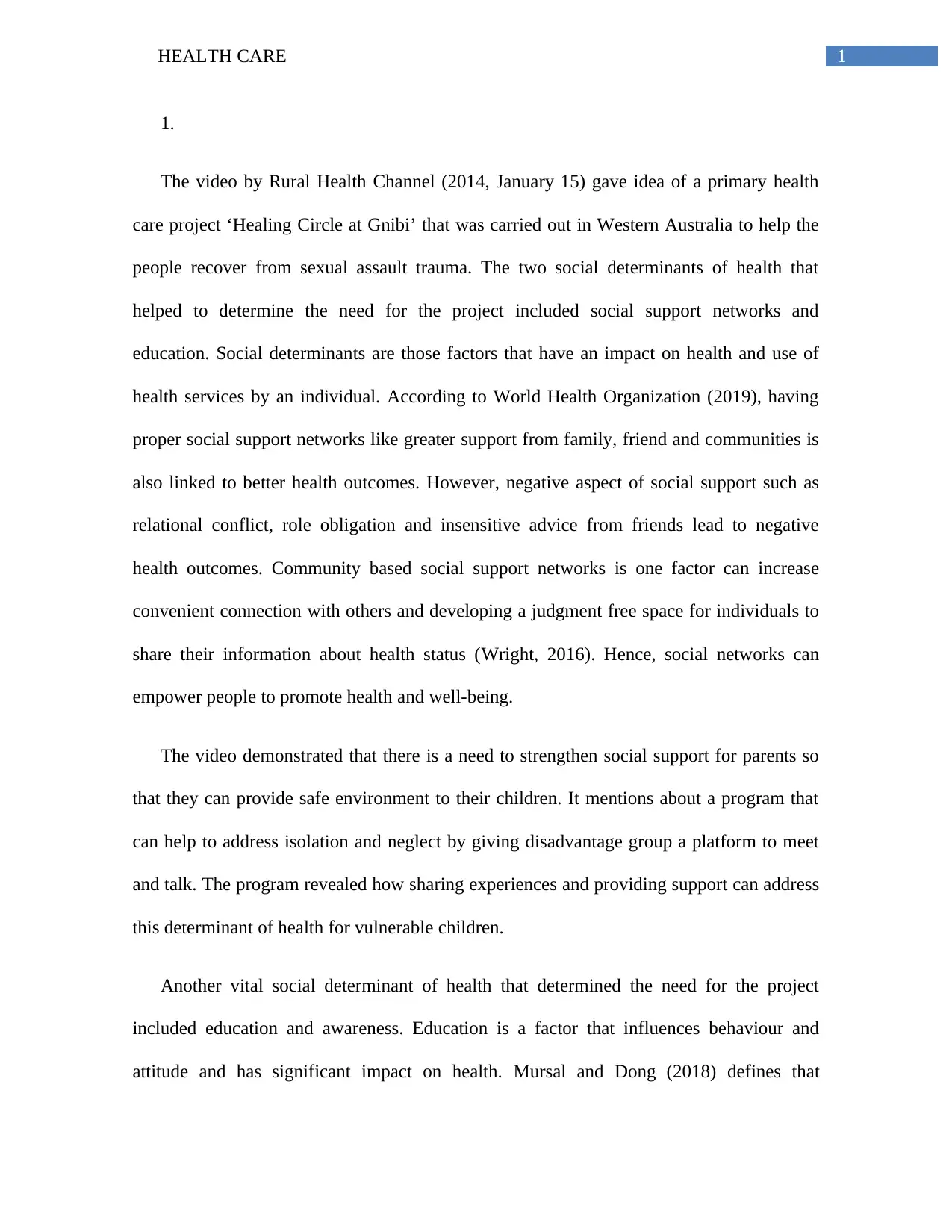
1HEALTH CARE
1.
The video by Rural Health Channel (2014, January 15) gave idea of a primary health
care project ‘Healing Circle at Gnibi’ that was carried out in Western Australia to help the
people recover from sexual assault trauma. The two social determinants of health that
helped to determine the need for the project included social support networks and
education. Social determinants are those factors that have an impact on health and use of
health services by an individual. According to World Health Organization (2019), having
proper social support networks like greater support from family, friend and communities is
also linked to better health outcomes. However, negative aspect of social support such as
relational conflict, role obligation and insensitive advice from friends lead to negative
health outcomes. Community based social support networks is one factor can increase
convenient connection with others and developing a judgment free space for individuals to
share their information about health status (Wright, 2016). Hence, social networks can
empower people to promote health and well-being.
The video demonstrated that there is a need to strengthen social support for parents so
that they can provide safe environment to their children. It mentions about a program that
can help to address isolation and neglect by giving disadvantage group a platform to meet
and talk. The program revealed how sharing experiences and providing support can address
this determinant of health for vulnerable children.
Another vital social determinant of health that determined the need for the project
included education and awareness. Education is a factor that influences behaviour and
attitude and has significant impact on health. Mursal and Dong (2018) defines that
1.
The video by Rural Health Channel (2014, January 15) gave idea of a primary health
care project ‘Healing Circle at Gnibi’ that was carried out in Western Australia to help the
people recover from sexual assault trauma. The two social determinants of health that
helped to determine the need for the project included social support networks and
education. Social determinants are those factors that have an impact on health and use of
health services by an individual. According to World Health Organization (2019), having
proper social support networks like greater support from family, friend and communities is
also linked to better health outcomes. However, negative aspect of social support such as
relational conflict, role obligation and insensitive advice from friends lead to negative
health outcomes. Community based social support networks is one factor can increase
convenient connection with others and developing a judgment free space for individuals to
share their information about health status (Wright, 2016). Hence, social networks can
empower people to promote health and well-being.
The video demonstrated that there is a need to strengthen social support for parents so
that they can provide safe environment to their children. It mentions about a program that
can help to address isolation and neglect by giving disadvantage group a platform to meet
and talk. The program revealed how sharing experiences and providing support can address
this determinant of health for vulnerable children.
Another vital social determinant of health that determined the need for the project
included education and awareness. Education is a factor that influences behaviour and
attitude and has significant impact on health. Mursal and Dong (2018) defines that
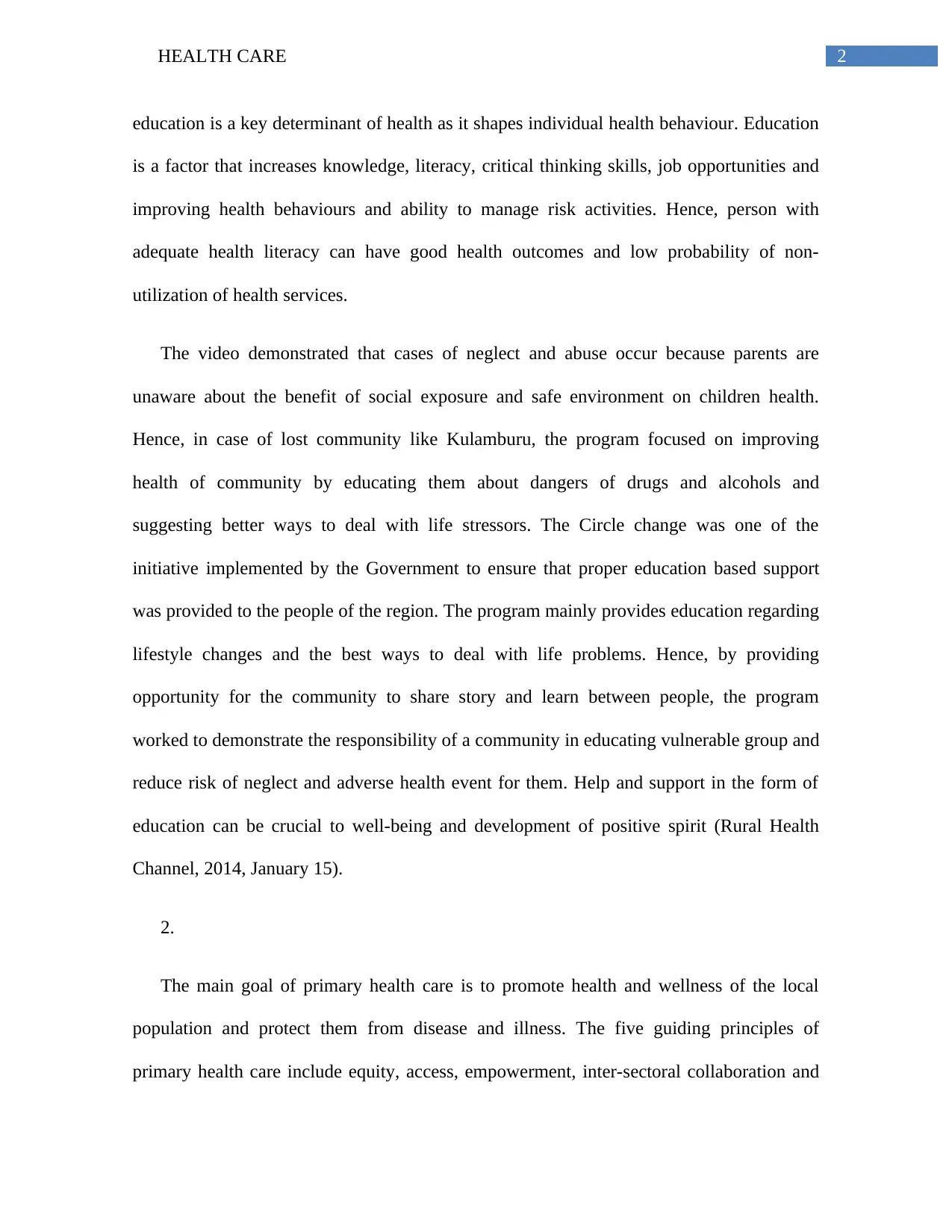
2HEALTH CARE
education is a key determinant of health as it shapes individual health behaviour. Education
is a factor that increases knowledge, literacy, critical thinking skills, job opportunities and
improving health behaviours and ability to manage risk activities. Hence, person with
adequate health literacy can have good health outcomes and low probability of non-
utilization of health services.
The video demonstrated that cases of neglect and abuse occur because parents are
unaware about the benefit of social exposure and safe environment on children health.
Hence, in case of lost community like Kulamburu, the program focused on improving
health of community by educating them about dangers of drugs and alcohols and
suggesting better ways to deal with life stressors. The Circle change was one of the
initiative implemented by the Government to ensure that proper education based support
was provided to the people of the region. The program mainly provides education regarding
lifestyle changes and the best ways to deal with life problems. Hence, by providing
opportunity for the community to share story and learn between people, the program
worked to demonstrate the responsibility of a community in educating vulnerable group and
reduce risk of neglect and adverse health event for them. Help and support in the form of
education can be crucial to well-being and development of positive spirit (Rural Health
Channel, 2014, January 15).
2.
The main goal of primary health care is to promote health and wellness of the local
population and protect them from disease and illness. The five guiding principles of
primary health care include equity, access, empowerment, inter-sectoral collaboration and
education is a key determinant of health as it shapes individual health behaviour. Education
is a factor that increases knowledge, literacy, critical thinking skills, job opportunities and
improving health behaviours and ability to manage risk activities. Hence, person with
adequate health literacy can have good health outcomes and low probability of non-
utilization of health services.
The video demonstrated that cases of neglect and abuse occur because parents are
unaware about the benefit of social exposure and safe environment on children health.
Hence, in case of lost community like Kulamburu, the program focused on improving
health of community by educating them about dangers of drugs and alcohols and
suggesting better ways to deal with life stressors. The Circle change was one of the
initiative implemented by the Government to ensure that proper education based support
was provided to the people of the region. The program mainly provides education regarding
lifestyle changes and the best ways to deal with life problems. Hence, by providing
opportunity for the community to share story and learn between people, the program
worked to demonstrate the responsibility of a community in educating vulnerable group and
reduce risk of neglect and adverse health event for them. Help and support in the form of
education can be crucial to well-being and development of positive spirit (Rural Health
Channel, 2014, January 15).
2.
The main goal of primary health care is to promote health and wellness of the local
population and protect them from disease and illness. The five guiding principles of
primary health care include equity, access, empowerment, inter-sectoral collaboration and
⊘ This is a preview!⊘
Do you want full access?
Subscribe today to unlock all pages.

Trusted by 1+ million students worldwide
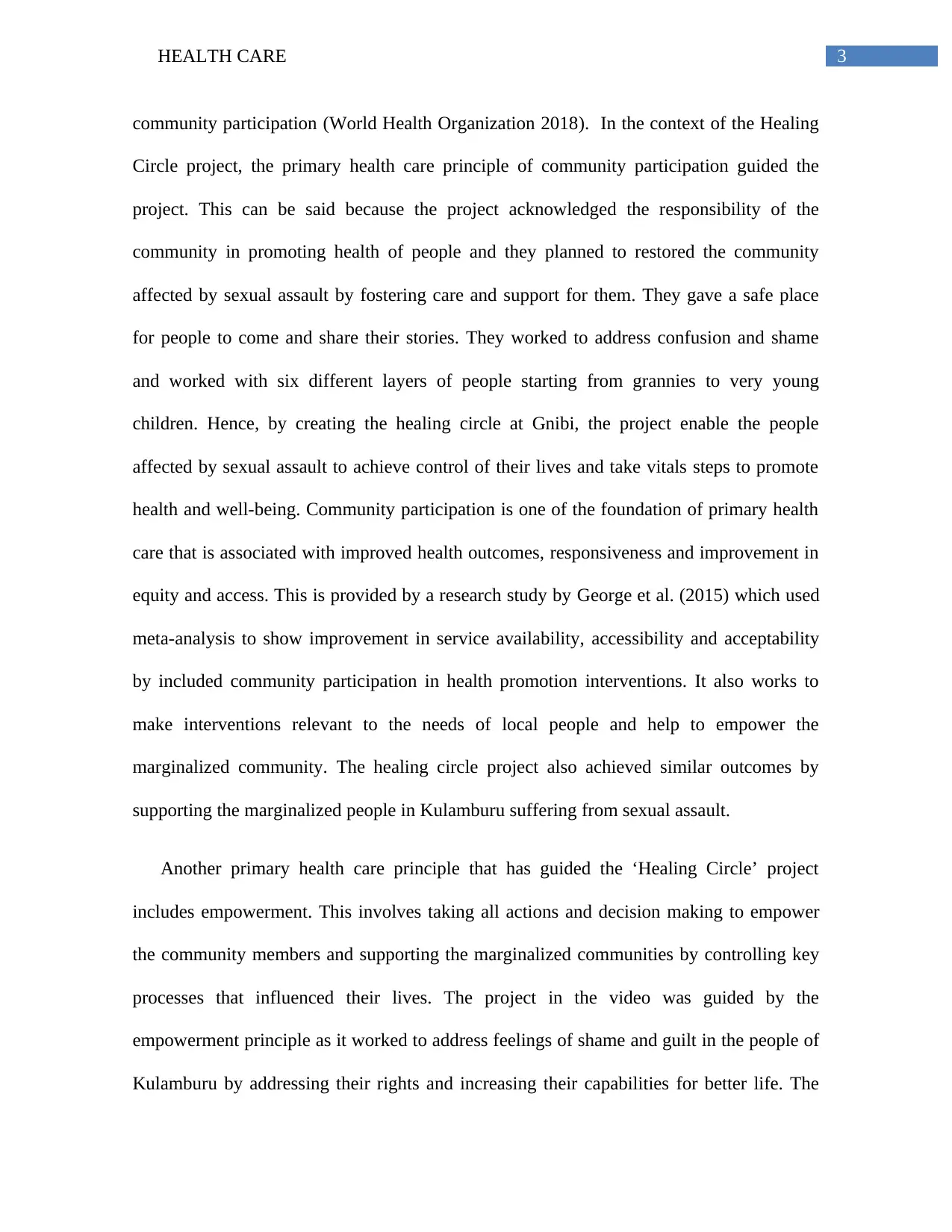
3HEALTH CARE
community participation (World Health Organization 2018). In the context of the Healing
Circle project, the primary health care principle of community participation guided the
project. This can be said because the project acknowledged the responsibility of the
community in promoting health of people and they planned to restored the community
affected by sexual assault by fostering care and support for them. They gave a safe place
for people to come and share their stories. They worked to address confusion and shame
and worked with six different layers of people starting from grannies to very young
children. Hence, by creating the healing circle at Gnibi, the project enable the people
affected by sexual assault to achieve control of their lives and take vitals steps to promote
health and well-being. Community participation is one of the foundation of primary health
care that is associated with improved health outcomes, responsiveness and improvement in
equity and access. This is provided by a research study by George et al. (2015) which used
meta-analysis to show improvement in service availability, accessibility and acceptability
by included community participation in health promotion interventions. It also works to
make interventions relevant to the needs of local people and help to empower the
marginalized community. The healing circle project also achieved similar outcomes by
supporting the marginalized people in Kulamburu suffering from sexual assault.
Another primary health care principle that has guided the ‘Healing Circle’ project
includes empowerment. This involves taking all actions and decision making to empower
the community members and supporting the marginalized communities by controlling key
processes that influenced their lives. The project in the video was guided by the
empowerment principle as it worked to address feelings of shame and guilt in the people of
Kulamburu by addressing their rights and increasing their capabilities for better life. The
community participation (World Health Organization 2018). In the context of the Healing
Circle project, the primary health care principle of community participation guided the
project. This can be said because the project acknowledged the responsibility of the
community in promoting health of people and they planned to restored the community
affected by sexual assault by fostering care and support for them. They gave a safe place
for people to come and share their stories. They worked to address confusion and shame
and worked with six different layers of people starting from grannies to very young
children. Hence, by creating the healing circle at Gnibi, the project enable the people
affected by sexual assault to achieve control of their lives and take vitals steps to promote
health and well-being. Community participation is one of the foundation of primary health
care that is associated with improved health outcomes, responsiveness and improvement in
equity and access. This is provided by a research study by George et al. (2015) which used
meta-analysis to show improvement in service availability, accessibility and acceptability
by included community participation in health promotion interventions. It also works to
make interventions relevant to the needs of local people and help to empower the
marginalized community. The healing circle project also achieved similar outcomes by
supporting the marginalized people in Kulamburu suffering from sexual assault.
Another primary health care principle that has guided the ‘Healing Circle’ project
includes empowerment. This involves taking all actions and decision making to empower
the community members and supporting the marginalized communities by controlling key
processes that influenced their lives. The project in the video was guided by the
empowerment principle as it worked to address feelings of shame and guilt in the people of
Kulamburu by addressing their rights and increasing their capabilities for better life. The
Paraphrase This Document
Need a fresh take? Get an instant paraphrase of this document with our AI Paraphraser
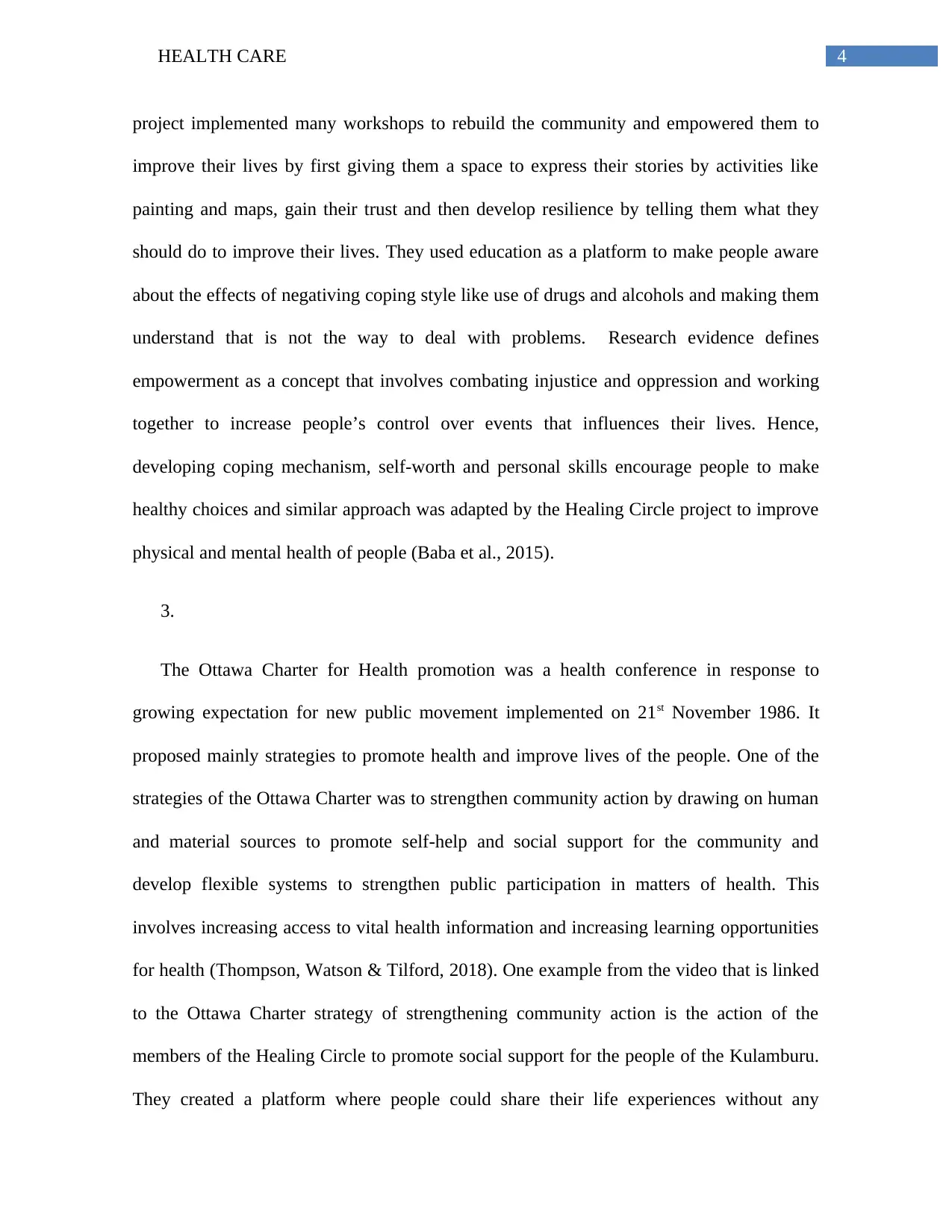
4HEALTH CARE
project implemented many workshops to rebuild the community and empowered them to
improve their lives by first giving them a space to express their stories by activities like
painting and maps, gain their trust and then develop resilience by telling them what they
should do to improve their lives. They used education as a platform to make people aware
about the effects of negativing coping style like use of drugs and alcohols and making them
understand that is not the way to deal with problems. Research evidence defines
empowerment as a concept that involves combating injustice and oppression and working
together to increase people’s control over events that influences their lives. Hence,
developing coping mechanism, self-worth and personal skills encourage people to make
healthy choices and similar approach was adapted by the Healing Circle project to improve
physical and mental health of people (Baba et al., 2015).
3.
The Ottawa Charter for Health promotion was a health conference in response to
growing expectation for new public movement implemented on 21st November 1986. It
proposed mainly strategies to promote health and improve lives of the people. One of the
strategies of the Ottawa Charter was to strengthen community action by drawing on human
and material sources to promote self-help and social support for the community and
develop flexible systems to strengthen public participation in matters of health. This
involves increasing access to vital health information and increasing learning opportunities
for health (Thompson, Watson & Tilford, 2018). One example from the video that is linked
to the Ottawa Charter strategy of strengthening community action is the action of the
members of the Healing Circle to promote social support for the people of the Kulamburu.
They created a platform where people could share their life experiences without any
project implemented many workshops to rebuild the community and empowered them to
improve their lives by first giving them a space to express their stories by activities like
painting and maps, gain their trust and then develop resilience by telling them what they
should do to improve their lives. They used education as a platform to make people aware
about the effects of negativing coping style like use of drugs and alcohols and making them
understand that is not the way to deal with problems. Research evidence defines
empowerment as a concept that involves combating injustice and oppression and working
together to increase people’s control over events that influences their lives. Hence,
developing coping mechanism, self-worth and personal skills encourage people to make
healthy choices and similar approach was adapted by the Healing Circle project to improve
physical and mental health of people (Baba et al., 2015).
3.
The Ottawa Charter for Health promotion was a health conference in response to
growing expectation for new public movement implemented on 21st November 1986. It
proposed mainly strategies to promote health and improve lives of the people. One of the
strategies of the Ottawa Charter was to strengthen community action by drawing on human
and material sources to promote self-help and social support for the community and
develop flexible systems to strengthen public participation in matters of health. This
involves increasing access to vital health information and increasing learning opportunities
for health (Thompson, Watson & Tilford, 2018). One example from the video that is linked
to the Ottawa Charter strategy of strengthening community action is the action of the
members of the Healing Circle to promote social support for the people of the Kulamburu.
They created a platform where people could share their life experiences without any
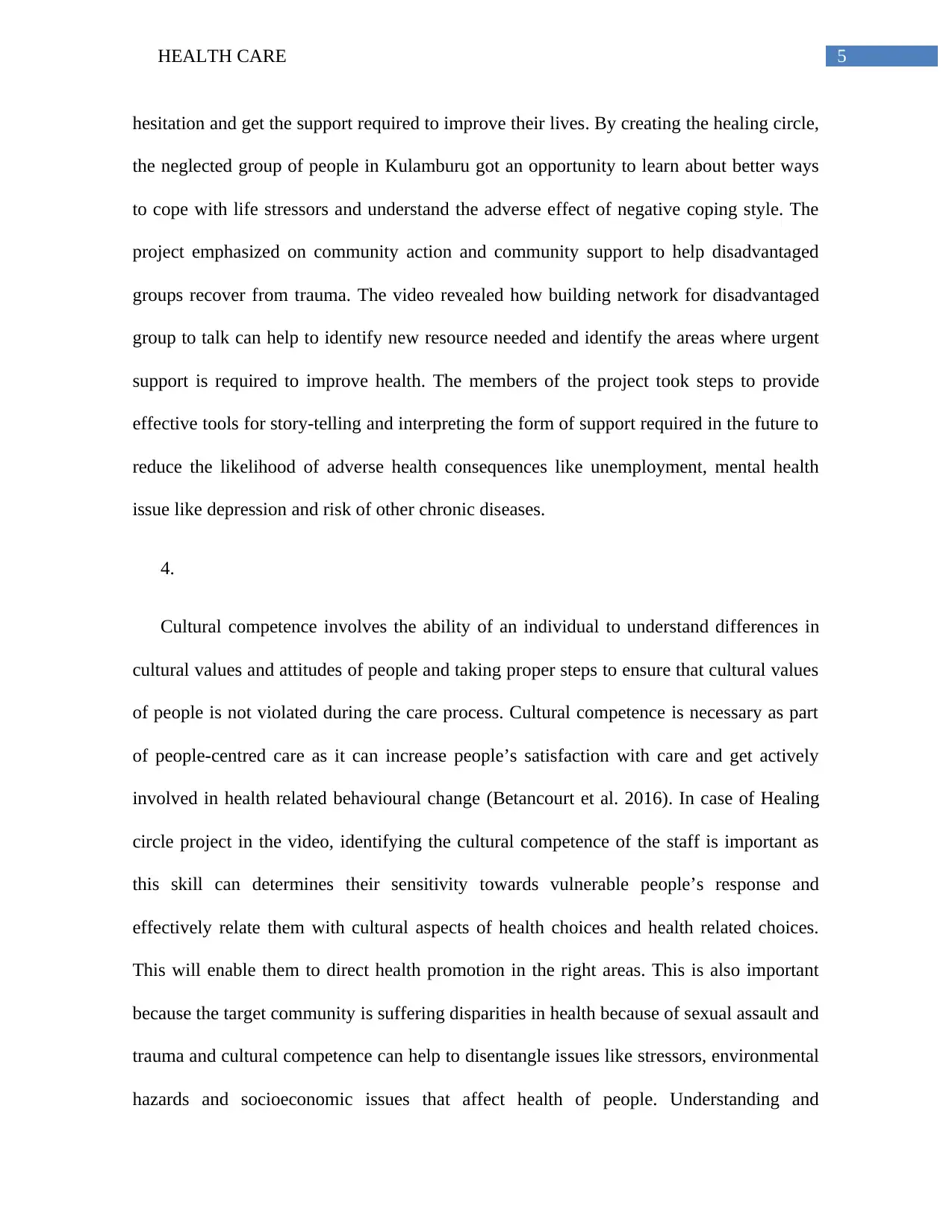
5HEALTH CARE
hesitation and get the support required to improve their lives. By creating the healing circle,
the neglected group of people in Kulamburu got an opportunity to learn about better ways
to cope with life stressors and understand the adverse effect of negative coping style. The
project emphasized on community action and community support to help disadvantaged
groups recover from trauma. The video revealed how building network for disadvantaged
group to talk can help to identify new resource needed and identify the areas where urgent
support is required to improve health. The members of the project took steps to provide
effective tools for story-telling and interpreting the form of support required in the future to
reduce the likelihood of adverse health consequences like unemployment, mental health
issue like depression and risk of other chronic diseases.
4.
Cultural competence involves the ability of an individual to understand differences in
cultural values and attitudes of people and taking proper steps to ensure that cultural values
of people is not violated during the care process. Cultural competence is necessary as part
of people-centred care as it can increase people’s satisfaction with care and get actively
involved in health related behavioural change (Betancourt et al. 2016). In case of Healing
circle project in the video, identifying the cultural competence of the staff is important as
this skill can determines their sensitivity towards vulnerable people’s response and
effectively relate them with cultural aspects of health choices and health related choices.
This will enable them to direct health promotion in the right areas. This is also important
because the target community is suffering disparities in health because of sexual assault and
trauma and cultural competence can help to disentangle issues like stressors, environmental
hazards and socioeconomic issues that affect health of people. Understanding and
hesitation and get the support required to improve their lives. By creating the healing circle,
the neglected group of people in Kulamburu got an opportunity to learn about better ways
to cope with life stressors and understand the adverse effect of negative coping style. The
project emphasized on community action and community support to help disadvantaged
groups recover from trauma. The video revealed how building network for disadvantaged
group to talk can help to identify new resource needed and identify the areas where urgent
support is required to improve health. The members of the project took steps to provide
effective tools for story-telling and interpreting the form of support required in the future to
reduce the likelihood of adverse health consequences like unemployment, mental health
issue like depression and risk of other chronic diseases.
4.
Cultural competence involves the ability of an individual to understand differences in
cultural values and attitudes of people and taking proper steps to ensure that cultural values
of people is not violated during the care process. Cultural competence is necessary as part
of people-centred care as it can increase people’s satisfaction with care and get actively
involved in health related behavioural change (Betancourt et al. 2016). In case of Healing
circle project in the video, identifying the cultural competence of the staff is important as
this skill can determines their sensitivity towards vulnerable people’s response and
effectively relate them with cultural aspects of health choices and health related choices.
This will enable them to direct health promotion in the right areas. This is also important
because the target community is suffering disparities in health because of sexual assault and
trauma and cultural competence can help to disentangle issues like stressors, environmental
hazards and socioeconomic issues that affect health of people. Understanding and
⊘ This is a preview!⊘
Do you want full access?
Subscribe today to unlock all pages.

Trusted by 1+ million students worldwide
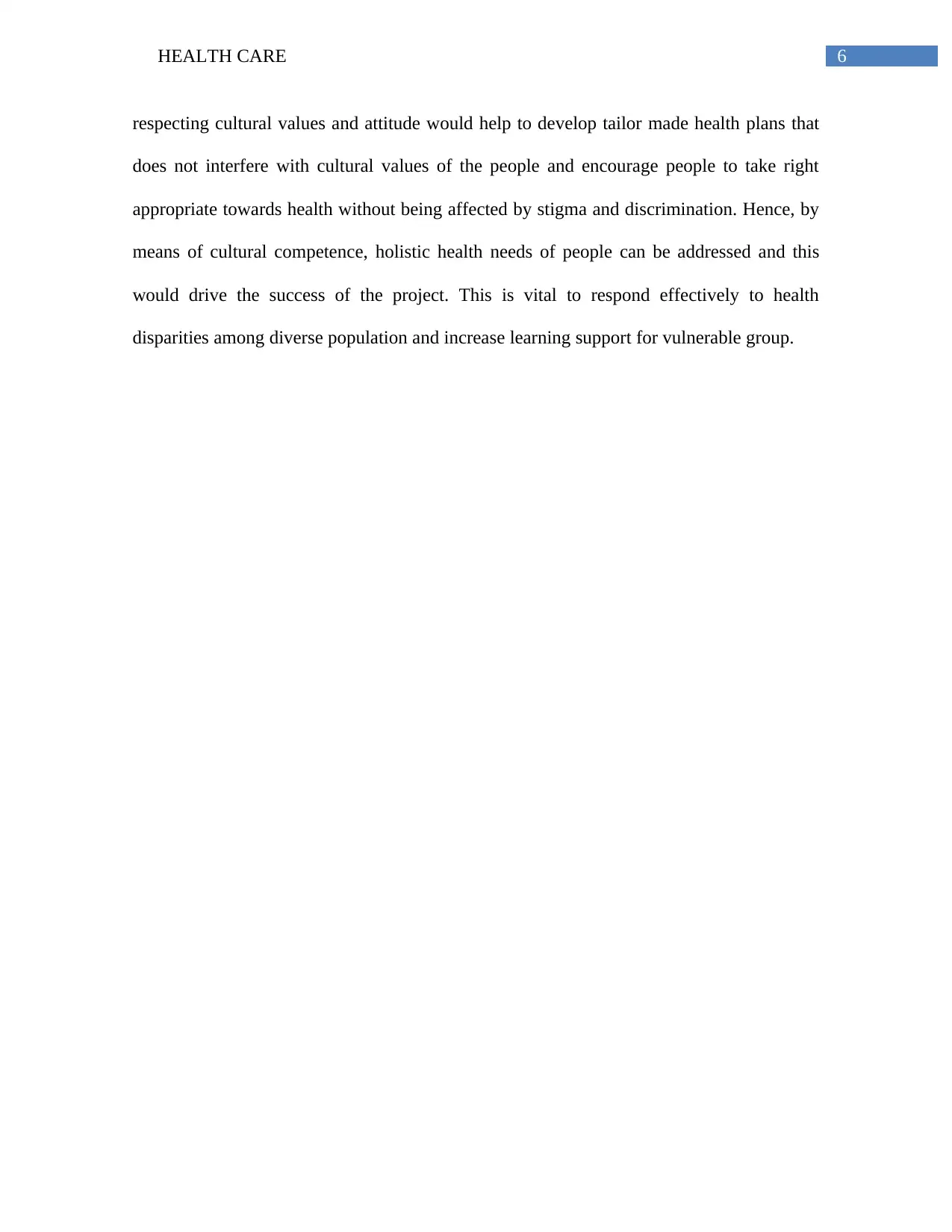
6HEALTH CARE
respecting cultural values and attitude would help to develop tailor made health plans that
does not interfere with cultural values of the people and encourage people to take right
appropriate towards health without being affected by stigma and discrimination. Hence, by
means of cultural competence, holistic health needs of people can be addressed and this
would drive the success of the project. This is vital to respond effectively to health
disparities among diverse population and increase learning support for vulnerable group.
respecting cultural values and attitude would help to develop tailor made health plans that
does not interfere with cultural values of the people and encourage people to take right
appropriate towards health without being affected by stigma and discrimination. Hence, by
means of cultural competence, holistic health needs of people can be addressed and this
would drive the success of the project. This is vital to respond effectively to health
disparities among diverse population and increase learning support for vulnerable group.
Paraphrase This Document
Need a fresh take? Get an instant paraphrase of this document with our AI Paraphraser
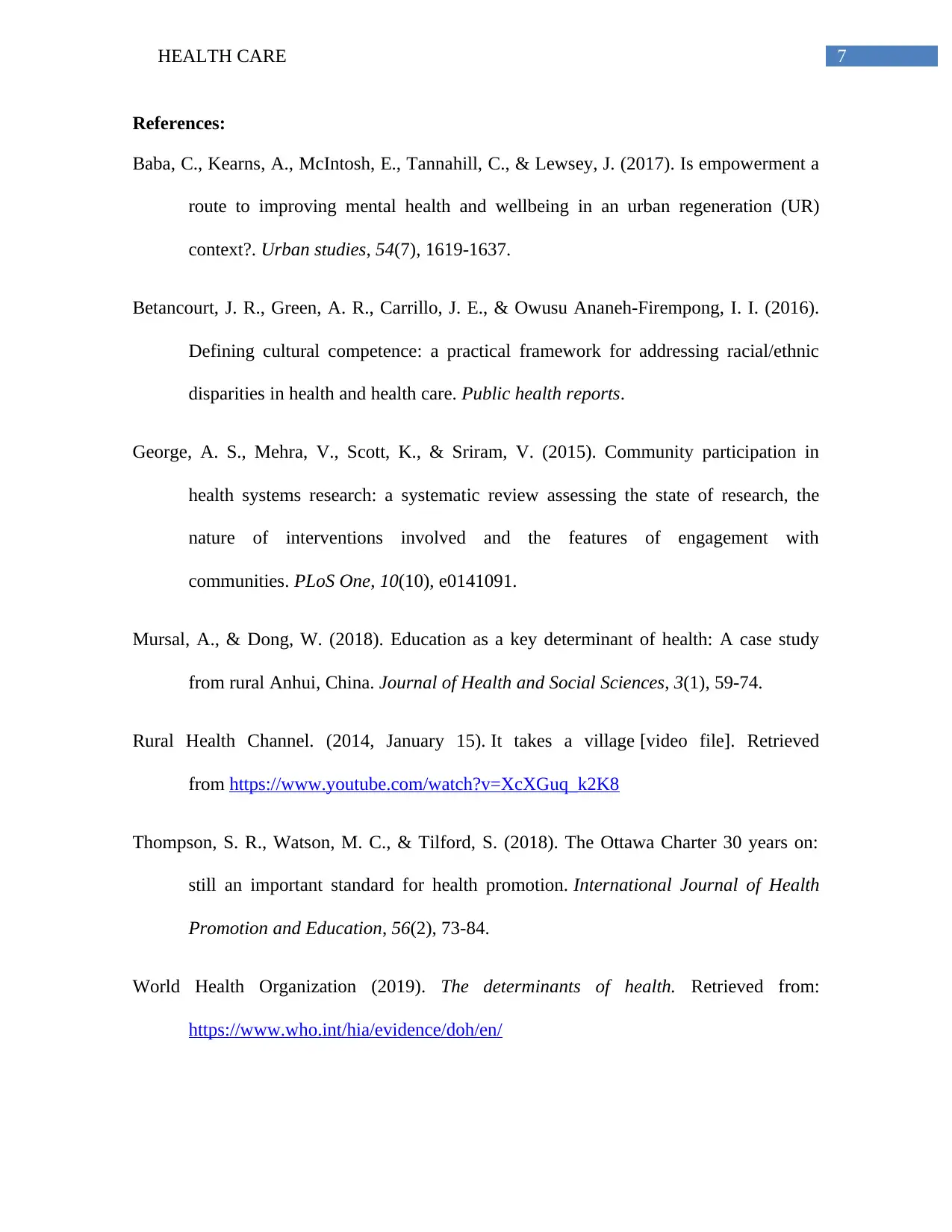
7HEALTH CARE
References:
Baba, C., Kearns, A., McIntosh, E., Tannahill, C., & Lewsey, J. (2017). Is empowerment a
route to improving mental health and wellbeing in an urban regeneration (UR)
context?. Urban studies, 54(7), 1619-1637.
Betancourt, J. R., Green, A. R., Carrillo, J. E., & Owusu Ananeh-Firempong, I. I. (2016).
Defining cultural competence: a practical framework for addressing racial/ethnic
disparities in health and health care. Public health reports.
George, A. S., Mehra, V., Scott, K., & Sriram, V. (2015). Community participation in
health systems research: a systematic review assessing the state of research, the
nature of interventions involved and the features of engagement with
communities. PLoS One, 10(10), e0141091.
Mursal, A., & Dong, W. (2018). Education as a key determinant of health: A case study
from rural Anhui, China. Journal of Health and Social Sciences, 3(1), 59-74.
Rural Health Channel. (2014, January 15). It takes a village [video file]. Retrieved
from https://www.youtube.com/watch?v=XcXGuq_k2K8
Thompson, S. R., Watson, M. C., & Tilford, S. (2018). The Ottawa Charter 30 years on:
still an important standard for health promotion. International Journal of Health
Promotion and Education, 56(2), 73-84.
World Health Organization (2019). The determinants of health. Retrieved from:
https://www.who.int/hia/evidence/doh/en/
References:
Baba, C., Kearns, A., McIntosh, E., Tannahill, C., & Lewsey, J. (2017). Is empowerment a
route to improving mental health and wellbeing in an urban regeneration (UR)
context?. Urban studies, 54(7), 1619-1637.
Betancourt, J. R., Green, A. R., Carrillo, J. E., & Owusu Ananeh-Firempong, I. I. (2016).
Defining cultural competence: a practical framework for addressing racial/ethnic
disparities in health and health care. Public health reports.
George, A. S., Mehra, V., Scott, K., & Sriram, V. (2015). Community participation in
health systems research: a systematic review assessing the state of research, the
nature of interventions involved and the features of engagement with
communities. PLoS One, 10(10), e0141091.
Mursal, A., & Dong, W. (2018). Education as a key determinant of health: A case study
from rural Anhui, China. Journal of Health and Social Sciences, 3(1), 59-74.
Rural Health Channel. (2014, January 15). It takes a village [video file]. Retrieved
from https://www.youtube.com/watch?v=XcXGuq_k2K8
Thompson, S. R., Watson, M. C., & Tilford, S. (2018). The Ottawa Charter 30 years on:
still an important standard for health promotion. International Journal of Health
Promotion and Education, 56(2), 73-84.
World Health Organization (2019). The determinants of health. Retrieved from:
https://www.who.int/hia/evidence/doh/en/
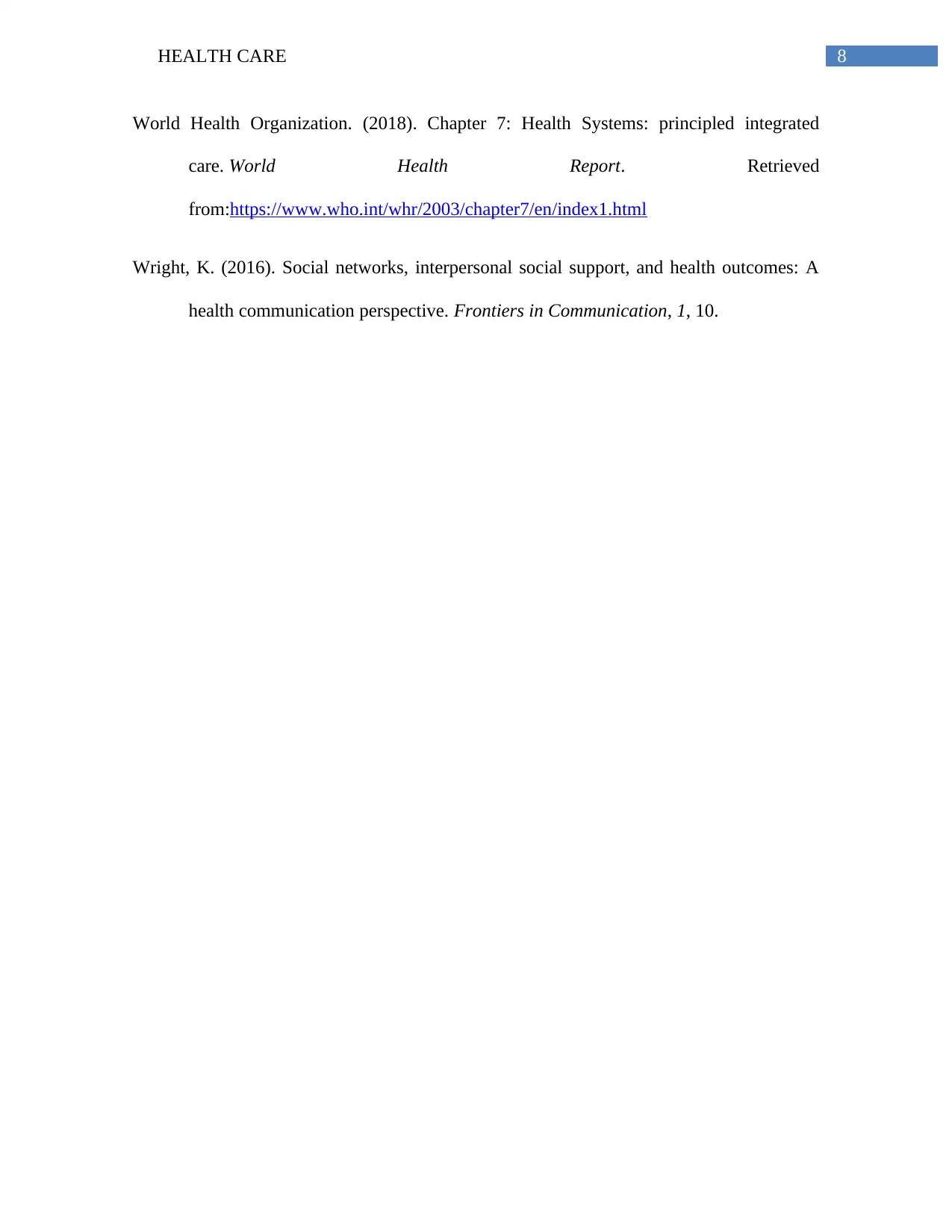
8HEALTH CARE
World Health Organization. (2018). Chapter 7: Health Systems: principled integrated
care. World Health Report. Retrieved
from:https://www.who.int/whr/2003/chapter7/en/index1.html
Wright, K. (2016). Social networks, interpersonal social support, and health outcomes: A
health communication perspective. Frontiers in Communication, 1, 10.
World Health Organization. (2018). Chapter 7: Health Systems: principled integrated
care. World Health Report. Retrieved
from:https://www.who.int/whr/2003/chapter7/en/index1.html
Wright, K. (2016). Social networks, interpersonal social support, and health outcomes: A
health communication perspective. Frontiers in Communication, 1, 10.
⊘ This is a preview!⊘
Do you want full access?
Subscribe today to unlock all pages.

Trusted by 1+ million students worldwide
1 out of 9
Related Documents
Your All-in-One AI-Powered Toolkit for Academic Success.
+13062052269
info@desklib.com
Available 24*7 on WhatsApp / Email
![[object Object]](/_next/static/media/star-bottom.7253800d.svg)
Unlock your academic potential
Copyright © 2020–2025 A2Z Services. All Rights Reserved. Developed and managed by ZUCOL.



